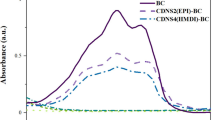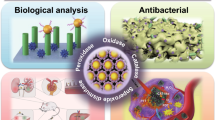Abstract
Methotrexate (MTX) is an antineoplastic drug widely used in cancer therapies with potentially toxic activity. This paper describes the electrochemical behavior of MTX in ITO (indium tin oxide) electrodes modified with nanostructured films containing biopolymers extracted from babassu mesocarp (BM) (Orbignya phalerata), aiming to develop electrochemical sensors for this drug. After combining PVS (polyvinyl sodium sulfonate) with BM, the analytical sensitivity of the sensor was improved from 2.49 (ITO) to 5.55 μA μmol L−1 (ITO/PVS/BM). The modification of the ITO with the proposed film yielded a detection limit of 5.95 × 10−7 mol L−1 for MTX. The presence of BM in the film considerably increased the sensor roughness as well as the interactions with MTX, which improved the analytical performance of the proposed system. This study demonstrated the possibility of quantifying MTX with electrochemical techniques using natural polymers, which can yield great financial and health benefits.











Similar content being viewed by others
References
Guerra MR, De Moura Gallo CV, Mendonça GAS (2005) The risk of cancer in Brazil: tendencies and recent epidemiologic studies. Rev Bras Cancerol 51:227–234
Maia PG, De Brito JC (2011) Riscos relacionados à exposição de trabalhadores a quimioterápicos antineoplásicos: uma análise crítica da produção científica brasileira. Revista Tempus Actas de Saúde Coletiva 5:251–265
Martins I, Della Rosa HV (2004) Considerações toxicológicas da exposição ocupacional aos fármacos antineoplásicos. Rev Bras Med Trab 2:118–125
Rizalar S, Tural E, Altay B (2012) Nurses’ protective measures during chemotherapy preparation and administration in Turkey. International Journal of Nursing Practice 18:91–98
Lutterbeck CA et al (2015) Removal of the anti-cancer drug methotrexate from water by advanced oxidation processes: aerobic biodegradation and toxicity studies after treatment. Chemosphere 141:290–296
Florea A et al (2015) Anticancer drug detection using a highly sensitive molecularly imprinted electrochemical sensor based on an electropolymerized microporous metal organic framework. Talanta 138:71–76
Lowinsohn D, Bertotti M (2006) Sensores eletroquímicos: considerações sobre mecanismos de funcionamento e aplicações no monitoramento de espécies químicas em ambientes microscópicos. Quim Nova 29:1318–1325
Wu X et al (2010) Functionalized Polyfluorene Film Sensors for Sensitive Detection of Iron (III) in both Organic and Aqueous Media. Macromolecules 43:8917–8923
James JZ, Lucas D, Koshland CP (2012) Gold nanoparticle films as sensitive and reusable elemental mercury. Sensors Environ. Sci. Technol 46:9557–9562
Ahmadi F et al (2015) Synthesis of Ag nanoparticles for the electrochemical detection of anticancer drug flutamide. Chin J Catal 36:439–445
Brahman PK et al (2012) Voltammetric determination of anticancer drug flutamide in surfactant media at polymer film modified carbon paste electrode. Colloids Surf A 396:8–15
Shojaei AF et al (2016) A novel 5-fluorouracile anticancer drug sensor based on ZnFe2O4 magnetic nanoparticles ionic liquids carbon paste electrode. Sens Actuators B 230:607–614
Ribeiro JA, Silva F, Pereira CM (2013) Electrochemical study of the anticancer drug daunorubicin at a water/oil interface: drug lipophilicity and quantification. Anal Chem 85:1582–1590
Hajian R et al (2015) Fabrication of an electrochemical sensor based on carbon nanotubes modified with gold nanoparticles for determination of valrubicin as a chemotherapy drug: valrubicin-DNA interaction. Materials Science and Engineering C 49:769–775
Beitollahi H, Raoof JB, Hosseinzadeh R (2011) Electroanalysis and simultaneous determination of 6-thioguanine in the presence of uric acid and folic acid using a modified carbon nanotube paste electrode. Anal Sci 27:991–997
Lima HRS, Silva JS, De Oliveira Farias EA, Teixeira PRS, Nunes LCC (2018) Electrochemical sensors and biosensors for the analysis of antineoplastic drugs. Biosens Bioelectron 15:27–37
Decher G (1997) Fuzzy nanoassembilies: toward layered polymeric multicomposites. Science 277:1232–1237
Egawa Y et al (2011) Electrochemical and optical sugar sensors based on phenylboronic acid and its derivatives. Mater Sci Eng C Mater Biol Appl 31:1257–1264
Mantha S et al (2010) Nanocomposite layer-by-layer assembled catalytic interfaces for biosensing applications. Langmuir 26:19114–19119
Teixeira PRS, Teixeira ASM, Farias EA et al (2018) Chemically modified babassu coconut (Orbignya sp.) biopolymer: characterization and development of a thin film for its application in electrochemical sensors. J Polym Res 25:127
Vieira AP et al (2009) Kinetics and thermodynamics of textile dye adsorption from aqueous solutions using babassu coconut mesocarp. J Hazard Mater 166:1272–1278
Eiras C, Santos AC, Zampa MF et al (2010) Natural polysaccarides as active biomaterials in nanostructured films for sensing. J Biomater Science 21:1533–1544
Eiras C et al (2007) Nanocompósitos eletroativos de poli-o-metoxianilina e polissacarídeos naturais. Quim Nova 30:1158–1162
Wei Y et al (2014) Highly sensitive determination of methotrexate at poly (l-lysine) modified electrode in the presence of sodium dodecyl benzene sulfonate. Bioelectrochemistry 98:70–75
Costa SMO, Rodrigues JPA, De Paula RCM (1996) Monitorização do Processo de Purificação de Gomas Naturais: Goma de Cajueiro. Polim: Cienc Tecnol 2:49–55
De Oliveira Farias EA, Nogueira SS, De Oliveira Farias AM et al (2017) A thin PANI and carrageenan–gold nanoparticle film on a flexible gold electrode as a conductive and low-cost platform for sensing in a physiological environment. J Mater Sci 52:13365–13377
Eaton P, West P (2010) At Force Microsc Oxford University Press. UK, Oxford
Torman VBL et al (2012) Normalidade de variáveis: métodos de verificação e comparação de alguns testes não-paramétricos por simulação. Rev HCPA 32:227–234
Gao L et al (2007) Anodic voltammetric behaviors of methotrexate at a glassy carbon electrode and its determination in spiked human urine. J Electroanal Chem 610:131–136
Wang F et al (2009) DNA Langmuir-Blodgett modified glassy carbon electrode as voltammetric sensor for determinate of methotrexate. Electrochim Acta 54:1408–1413
Wang Y et al (2012a) Electrochemical oxidation behavior of methotrexate at DNA/SWCNT/Nafion composite film-modified glassy carbon electrode. J Solid State Electrochem 16:3227–3235
Pontinha ADR et al (2012) Antineoplasic drug methotrexate redox mechanism using a glassy carbon electrode. Electroanalysis 24:917–923
Mahdavinia GR et al (2017) Magnetic and pH-responsive κ-carrageenan/chitosan complexes for controlled release of methotrexate anticancer drug. Int J Biol Macromol 97:209–217
Santos AC et al (2010) Organização supramolecular da ftalocianina de cobalto (II) e seu efeito na oxidação do aminoácido cisteína. Quim Nova 33:539–546
Silva WC et al (2009) Synergistic interaction between gold nanoparticles and nickel phthalocyanine in layer-by-layer (LbL) films: evidence of constitutional dynamic chemistry (CDC). Chem. Phys 11:5086–5091
De Oliveira RF, Xavier ACF, De Barros A, Ferreira M (2015) Filmes nanoestruturados: técnicas de Langmuir Blodgett (LB) e Layer-by-layer (LBL). Nanoestruturas 1:123–145
De Souza D, Machado SAS, Avaca LA (2003) Voltametria de onda quadrada. Primeira parte: Aspectos teóricos. Quim Nova 26:81–89
Rubino FM (2001) Separation methods for methotrexate, its structural analogues and metabolites. J Chromatogr B Biomed Sci Appl 764:217–254
Zhang G (2015) Nanoscale surface modification for enhanced biosensing: a journey toward better glucose monitoring. Springer, Berlin
Acknowledgments
The authors would like to thank the Federal University of Piauí (UFPI) and Federal Institute of Piauí (IFPI) for providing the research and work facilities.
Funding
The authors would like to thank the Coordination for the Improvement of Higher Education Personnel (CAPES), National Council for Scientific and Technological Development (CNPq, grant number 001), and Foundation for Research Support of Piauí (FAPEPI) for their financial support.
Author information
Authors and Affiliations
Corresponding author
Ethics declarations
Conflict of interest
The authors declare that they have no conflict of interest.
Additional information
Publisher’s note
Springer Nature remains neutral with regard to jurisdictional claims in published maps and institutional affiliations.
Rights and permissions
About this article
Cite this article
Lima, H.R.S., Airton de Oliveira Farias, E., Teixeira, P.R.S. et al. Blend films based on biopolymers extracted from babassu mesocarp (Orbignya phalerata) for the electrochemical detection of methotrexate antineoplastic drug. J Solid State Electrochem 23, 3153–3164 (2019). https://doi.org/10.1007/s10008-019-04406-2
Received:
Revised:
Accepted:
Published:
Issue Date:
DOI: https://doi.org/10.1007/s10008-019-04406-2




